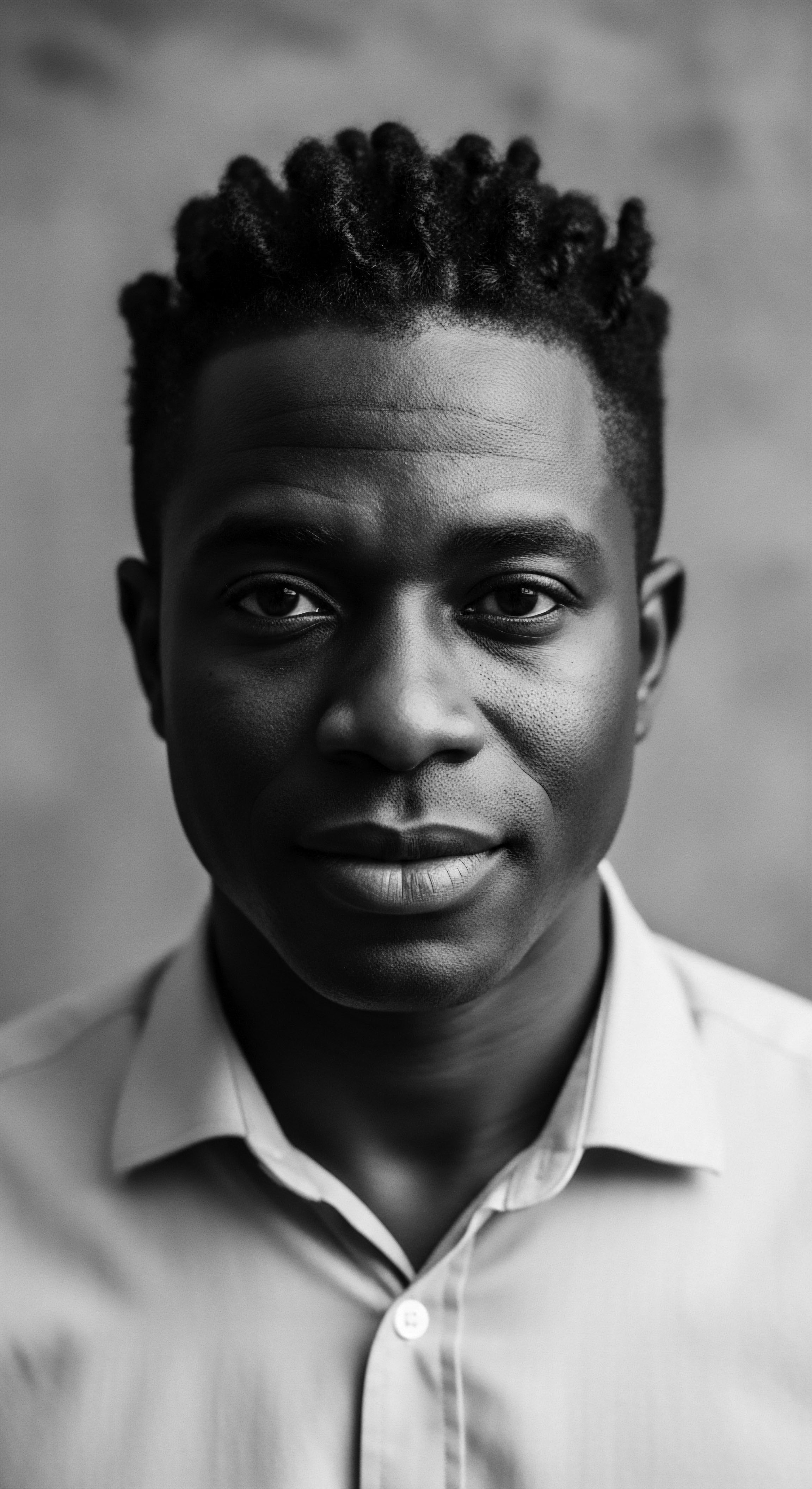
Fundamentals
Within Roothea’s expansive living library, the concept of Mummified Hair Studies stands as a profound entry, a silent witness to the enduring narratives etched within each strand. This discipline, at its foundational core, represents the careful, respectful examination of hair preserved through the passage of millennia, often found in archaeological contexts such as ancient tombs or natural environments that halt the decay of organic matter. It is a field that seeks to unearth not merely biological data, but the deeper cultural significance, ancestral practices, and the very essence of identity that hair conveyed across diverse human societies. For those new to this specialized area, envisioning hair as an intimate, personal archive, capable of whispering stories from distant epochs, provides a starting point for understanding its immense value.
The preservation of hair, whether through intentional mummification processes or natural conditions like extreme aridity or cold, creates unique opportunities for scholars. These ancient strands, often remarkably intact, hold secrets about diet, health, migration patterns, and, most compellingly for Roothea, the intricate styling and care rituals that defined communities long vanished. The initial investigations into these preserved tresses begin with a delicate touch, recognizing that each fragment carries the energetic imprint of a life lived. This elemental engagement with ancient hair is the first step in translating its silence into resonant understanding, connecting us to the past in a truly tangible way.
The meaning of Mummified Hair Studies, even at a fundamental level, extends beyond mere scientific curiosity; it offers a direct portal into the human experience of ancient peoples. It clarifies how they interacted with their physical selves and their environment, often revealing sophisticated knowledge of natural resources for grooming and adornment. This foundational understanding sets the stage for appreciating the depth of heritage embedded within our own hair traditions today.

The Silent Archivists ❉ Hair as a Historical Record
Hair, unlike many other soft tissues, possesses a remarkable resilience, capable of withstanding the ravages of time under specific conditions. Its fibrous protein structure, primarily keratin, grants it a durability that transforms it into a microscopic chronicle of existence. Each growth segment of a strand records environmental exposures, nutritional intake, and even certain chemical applications, making it a unique biological timestamp.
For ancient communities, particularly those with rich traditions of elaborate hair artistry, the hair was not merely an aesthetic adornment; it served as a visible lexicon of social standing, spiritual devotion, and communal belonging. When these physical expressions of identity become preserved, Mummified Hair Studies gains the ability to read these ancient texts, offering insights into the nuanced ways hair reflected and shaped societal structures. This initial phase of inquiry, therefore, respects the hair as a profound document, patiently awaiting its story to be told.
Mummified Hair Studies unlocks the silent narratives of ancient peoples, revealing their cultural expressions and care traditions through preserved strands.
The initial investigations often involve visual inspection and basic microscopy, allowing researchers to observe the macroscopic characteristics of the hair, such as its color, texture, and any discernible styling patterns. These early observations provide the first clues, hinting at the potential wealth of information held within. The subsequent stages of study build upon this foundational visual evidence, delving into the microscopic and molecular realms to extract deeper insights.
- Visual Assessment ❉ Observing overall color, length, and the presence of braids, twists, or other styles.
- Macroscopic Patterns ❉ Identifying any discernible historical styling or adornment techniques, such as the use of natural fibers or ornaments.
- Environmental Clues ❉ Noting the state of preservation and any adhering soil or materials that offer context about the burial environment.

Intermediate
Expanding upon the foundational understanding, the intermediate exploration of Mummified Hair Studies delves into the methodological sophistication required to interpret the deeper significance of ancient hair. Here, the scientific rigor of analysis begins to interweave with the profound cultural implications, particularly for textured hair heritage. The meaning of these studies expands to encompass the biochemical and structural integrity of preserved hair, allowing us to discern the subtle yet powerful echoes of ancestral care practices and the ingenuity of ancient communities. It is through these more detailed examinations that we begin to perceive how modern science often affirms the deep wisdom embedded in historical traditions.
Specialized techniques come into play, moving beyond simple observation to chemical and structural analyses. Gas chromatography-mass spectrometry, for instance, can identify residual organic compounds, revealing the types of emollients, dyes, or styling agents used. Microscopic imaging, including scanning electron microscopy, permits an examination of the hair cuticle and cortex at an unparalleled resolution, exposing details about hair health, damage, and even the tools used for grooming. This level of inquiry transforms Mummified Hair Studies into a bridge, connecting the material reality of ancient strands with the intangible legacy of their caretakers.

Unveiling Ancient Hair Care Regimens
The preservation of hair in ancient contexts frequently offers compelling evidence of sophisticated hair care. For example, analysis of mummified hair from ancient Egypt has revealed the consistent application of a fat-based substance, likely a styling product, used to maintain elaborate coiffures both in life and in preparation for the afterlife (McCreesh, Gize, & David, 2011). This finding does not merely speak to ancient aesthetics; it underscores a profound understanding of hair manipulation and preservation, often using naturally occurring lipids and resins. Such discoveries highlight the ancestral ingenuity in formulating products that provided both structural hold and conditioning benefits, demonstrating an early form of hair science rooted in observation and experimentation.
Intermediate studies of mummified hair reveal sophisticated ancient care practices, validating ancestral wisdom through scientific analysis of preserved emollients and styling techniques.
The chemical composition of these ancient hair applications often aligns with ethnobotanical records, which document the traditional use of plant-derived oils, butters, and extracts for skin and hair health across various African cultures (Yingngam, 2024b). This convergence of archaeological evidence and ethnobotanical knowledge offers a richer, more comprehensive interpretation of ancient hair care, demonstrating a continuum of natural wellness practices that have sustained textured hair for generations. The detailed analysis of these ancient formulations provides valuable insights into the properties and benefits of ingredients that remain relevant in contemporary natural hair care.
- Lipid Analysis ❉ Identification of fatty acids and other lipids used as ancient conditioners, pomades, or styling agents.
- Pigment Examination ❉ Investigation of natural dyes or colorants applied to hair, indicating aesthetic or ceremonial practices.
- Structural Integrity ❉ Assessment of cuticle scales and cortical cells to infer the health of the hair and the impact of environmental factors or care methods.

The Ancestral Wisdom Encoded in Structure
The intrinsic structure of textured hair, characterized by its unique curl patterns, varying diameters, and often a flatter elliptical cross-section, holds immense cultural and historical significance. Mummified Hair Studies, at this intermediate stage, can offer insights into the genetic and morphological diversity of ancient populations. By examining the micro-architecture of ancient hair, researchers can gain a deeper understanding of the phenotypic variations that have existed for millennia.
| Ancient Component/Practice Fat-based Emollients |
| Observed in Mummified Hair Studies Identified on Egyptian mummies, likely animal fats or plant oils (McCreesh, Gize, & David, 2011). |
| Contemporary Relevance for Textured Hair Heritage Continues as a cornerstone of Black and mixed-race hair care, with natural butters (shea, cocoa) and oils (coconut, jojoba) providing moisture and protection. |
| Ancient Component/Practice Natural Resins/Gums |
| Observed in Mummified Hair Studies Used for setting styles and potentially for their preservative qualities. |
| Contemporary Relevance for Textured Hair Heritage Inspiration for natural hold products, demonstrating ancestral understanding of botanical fixatives. |
| Ancient Component/Practice Intricate Braiding/Plaiting |
| Observed in Mummified Hair Studies Evident in numerous ancient African and diasporic archaeological findings. |
| Contemporary Relevance for Textured Hair Heritage Foundation of protective styling, preserving hair length and health, and a powerful symbol of cultural identity and artistry. |
| Ancient Component/Practice Head Adornments/Wigs |
| Observed in Mummified Hair Studies Worn by elites in ancient Egypt and Nubia, often made of human hair or plant fibers. |
| Contemporary Relevance for Textured Hair Heritage Acknowledging the long history of hair augmentation as an expression of status and creativity within Black hair culture. |
| Ancient Component/Practice These findings underscore the deep continuity of hair care wisdom from ancient times to the present, particularly within textured hair communities. |
The preservation quality of hair in mummified remains, even after thousands of years, provides a testament to the resilience of the hair fiber itself. This durability, coupled with the unique structural characteristics of textured hair, allowed for the survival of complex hairstyles and cultural markers that would otherwise be lost to time. The ability to discern these enduring qualities through scientific analysis enriches our appreciation for the adaptive nature of hair and the knowledge systems that supported its care.

Academic
The academic understanding of Mummified Hair Studies transcends mere identification of ancient hair and its treatments; it represents a rigorous, interdisciplinary inquiry into the profound intersection of human biology, cultural expression, and historical continuity, particularly as it pertains to textured hair heritage. At this advanced level, the term signifies the systematic application of cutting-edge analytical methodologies to preserved hair samples, not simply to define their composition, but to explicate their deep significance as irreplaceable anthropological and genetic archives. This scholarly pursuit illuminates how hair served as a dynamic medium for identity, social status, spiritual beliefs, and the transmission of ancestral knowledge across millennia, especially within African and diasporic communities where hair held, and continues to hold, immense cultural weight. The academic delineation of Mummified Hair Studies therefore becomes a powerful tool for decolonizing historical narratives, giving voice to the otherwise silent experiences of our forebears through the enduring testimony of their strands.
The meaning of Mummified Hair Studies, when viewed through an academic lens, is not static; it is a continuously evolving clarification, informed by new archaeological discoveries, advancements in biomolecular techniques, and a more inclusive historical perspective. It compels us to move beyond superficial observations, prompting a deeper investigation into the complex interplay of genetics, environment, and cultural agency that shaped ancient hair experiences. The field draws upon diverse academic disciplines, including bioarchaeology, forensic anthropology, ethnobotany, genetics, and cultural studies, to construct a holistic interpretation of hair’s past. This multi-faceted approach allows for a comprehensive elucidation of hair’s role as a biological specimen, a cultural artifact, and a symbol of enduring heritage.

Echoes from the Source ❉ Hair as a Genetic and Phenotypic Ledger
From an academic perspective, Mummified Hair Studies offers an unparalleled opportunity to explore the genetic lineages and phenotypic diversity of ancient populations, particularly those with textured hair. Hair, composed primarily of keratin proteins, provides a stable matrix for the preservation of DNA, even in challenging environmental conditions where bone preservation might be compromised. A compelling case in point comes from a study published in 2022, which successfully reconstructed and analyzed genome-wide data from the naturally mummified hair of a 4000-year-old individual from Sudan in northeastern Africa. This groundbreaking research, led by Epperson and colleagues, achieved DNA extraction from hair after repeated failures with teeth, petrous bones, and cranium samples from the same and other individuals from the Kadruka cemeteries (Epperson et al.
2022). This finding profoundly shifts our understanding of hair’s potential as an ancient DNA source, especially in hot, arid climates common across Africa, where skeletal remains often degrade rapidly.
The Epperson et al. (2022) study revealed that the ancient DNA from the Sudanese hair was genetically indistinguishable from early Neolithic eastern African pastoralists located thousands of kilometers away. This provides powerful genetic support for established models concerning the southward dispersal of Middle Nile Valley pastoral populations into the Rift Valley of eastern Africa, offering a possible genetic source population for this significant migration.
The unique insights gained from this specific hair sample underscore the critical value of Mummified Hair Studies in tracing human population movements and genetic relationships over vast geographical and temporal scales. It is a testament to hair’s capacity to serve as a biological blueprint, mapping ancestral journeys and revealing the deep roots of human diversity.
Academic Mummified Hair Studies leverage advanced biomolecular techniques to unravel ancient genetic lineages and population migrations, as exemplified by successful DNA extraction from 4000-year-old Sudanese hair.
Beyond genetic information, the morphological analysis of mummified hair offers critical insights into the physical characteristics of ancient textured hair. A seminal study by Hrdy (1978) on hair samples from 76 burials at Semna South in Sudanese Nubia utilized a variety of techniques, including electrophoresis, fluorescence microscopy, and metric analysis. The findings indicated that while some oxidation of the cuticle and keratin protein had occurred, the overall structure remained well-preserved due to the low humidity and non-alkaline burial conditions. Crucially, the metric analysis of hair form revealed “curling variables intermediate between European and African samples,” with the X-group males, in particular, exhibiting “more African elements” in their curling patterns (Hrdy, 1978, p.
277). This specific data point is invaluable for understanding the continuum of textured hair characteristics within ancient African populations and provides a scientific basis for recognizing the historical presence and diversity of hair forms often associated with Black and mixed-race heritage.
The detailed explication of these findings allows for a more nuanced understanding of ancient human variation and challenges simplistic racial classifications often imposed on historical populations. The preservation of these unique curling patterns, even after millennia, speaks to the inherent resilience of textured hair and the sophisticated knowledge ancient communities possessed regarding its care and styling. This rigorous analysis provides objective evidence that complements the rich cultural narratives of hair in Africa.

The Tender Thread ❉ Ancestral Practices and Cultural Resilience
The academic investigation of Mummified Hair Studies is incomplete without a profound exploration of the cultural practices and belief systems that shaped ancient hair traditions. Hair, particularly within African societies, was rarely merely a biological appendage; it was a potent symbol, a canvas for artistry, and a repository of communal values. The delineation of these practices through archaeological evidence, alongside historical texts and ethnobotanical research, offers a window into the deep heritage of textured hair care.
Consider the widespread evidence of intricate braiding, plaiting, and coiling techniques found in mummified remains from various African cultures, dating back thousands of years. These styles were not arbitrary; they often communicated marital status, age, social hierarchy, and spiritual affiliations (Rubin, 1988). The continuity of these styling methods into contemporary Black and mixed-race hair practices underscores a living heritage, a testament to the resilience and adaptability of ancestral knowledge. The academic analysis of these preserved styles allows us to appreciate the sophistication of ancient hair artistry and its enduring cultural significance.
The study of ancient hair adornments, such as combs and pins, also contributes significantly to this academic understanding. The “Origins of the Afro Comb” exhibition, for example, traces the history of African hair combs over 5,500 years, from ancient Egypt through the diaspora, highlighting their symbolic role in expressing status, group affiliation, and religious beliefs (Fitzwilliam Museum, 2013; UCL Blogs, 2013). Archaeological findings of combs at African-American sites, even during periods of enslavement, indicate the enduring importance of hair care and adornment as an expression of personal aesthetic and cultural continuity (Wilkie & Farnsworth, 1992, 1993, as cited in ScholarWorks@UMass). This persistent attention to hair, even under oppressive conditions, speaks volumes about its role in preserving identity and resilience.
The use of natural ingredients for hair care, often identified through chemical analysis of mummified hair and confirmed by ethnobotanical studies, reveals a deep, ancestral connection to the earth’s bounty. Ancient Egyptians, for instance, utilized a variety of plant-derived substances, including aloe, gum, myrrh, and poppy, for both medicinal and cosmetic purposes, often applied to hair and scalp (Yingngam, 2024b). In ancient Nubia, oils were applied to hydrate skin and hair, a practice that persists in modern Nubian communities (Raafat El-Sayed & El-Din Fouad, 2020, as cited in Arcadia, 2023). This enduring wisdom, passed down through generations, highlights a holistic approach to wellness where hair care was intrinsically linked to overall health and spiritual well-being.
The academic interpretation of Mummified Hair Studies thus provides a rigorous framework for understanding the profound historical and cultural depth of textured hair practices. It moves beyond mere artifact collection to a deep analysis of the knowledge systems, social structures, and enduring cultural values that shaped ancient hair traditions, offering invaluable insights for contemporary discourse on heritage and identity.

The Unbound Helix ❉ Interconnectedness and Future Trajectories
The academic meaning of Mummified Hair Studies also extends to its capacity to illuminate interconnected incidences across various fields, particularly concerning human health, migration, and the impact of environmental factors on ancient populations. The detailed analysis of chemical markers within ancient hair can provide a dietary history, indicating nutritional deficiencies or exposure to toxins, thereby offering a window into the health and living conditions of past societies. This form of chemical explication contributes to a broader understanding of historical epidemiology and environmental archaeology.
Furthermore, the study of ancient hair offers insights into the evolution of hair treatments and their potential long-term consequences. By analyzing the residues of ancient hair products, researchers can assess the efficacy and safety of traditional formulations, drawing parallels to modern cosmetic science. This academic pursuit fosters a deeper appreciation for the ingenuity of ancestral practices, often demonstrating their effectiveness without the synthetic compounds prevalent today. The continuous thread of innovation in hair care, from ancient remedies to contemporary formulations, is a subject ripe for further academic exploration.
The implications of Mummified Hair Studies for contemporary understanding of textured hair are profound. By scientifically validating the sophistication of ancient African hair care practices, these studies challenge Eurocentric beauty standards that historically devalued textured hair. They provide concrete evidence of a rich, complex heritage of hair artistry and maintenance that predates and often surpasses many later European innovations.
This academic grounding offers a powerful counter-narrative, affirming the inherent beauty and resilience of textured hair and empowering individuals to connect with their ancestral legacy. The insights gleaned from mummified hair can inform culturally sensitive approaches to modern hair care, encouraging the use of natural ingredients and protective styles rooted in centuries of wisdom.
One particularly insightful area of study involves the examination of hair from various social strata within ancient societies. While elite individuals often left behind more elaborate burials, studies of hair from common burials can reveal widespread practices and health indicators across the broader population. This comparative analysis provides a more complete picture of daily life and hair care accessibility.
For example, the types of oils or styling agents found on hair from different social classes can indicate economic disparities or the availability of certain resources. The meticulous delineation of these variations adds another layer of complexity to our understanding of ancient social structures and their relationship to hair.
The study of mummified hair also contributes to the understanding of ancient textile production and adornment. Often, hair was used in the creation of wigs, extensions, or integrated into elaborate headpieces. The techniques used to attach, style, and maintain these hair artifacts can provide insights into ancient craftsmanship and the symbiotic relationship between hair, textiles, and jewelry. This interconnectedness highlights hair’s role not just as a biological feature, but as a component of a larger system of personal and communal adornment.
- Archaeological Contextualization ❉ Placing hair findings within their broader archaeological site, considering burial practices, associated artifacts, and environmental conditions for a comprehensive interpretation.
- Biomolecular Analysis ❉ Utilizing advanced techniques like ancient DNA sequencing, stable isotope analysis for dietary reconstruction, and proteomic studies to identify hair proteins and their modifications.
- Ethnohistorical and Ethnobotanical Integration ❉ Cross-referencing scientific findings with historical texts, oral traditions, and traditional knowledge of plant uses for hair and skin care.
- Comparative Anthropology ❉ Drawing comparisons with hair practices in other ancient and contemporary cultures to identify patterns, convergences, and unique cultural adaptations related to hair.
The academic rigor applied to Mummified Hair Studies therefore enables a profound re-evaluation of human history, particularly regarding the often-overlooked contributions and experiences of African peoples. It offers concrete, empirically derived evidence that supports and enriches the vibrant oral traditions and cultural memories of textured hair heritage, ensuring that these ancient voices continue to inform and inspire future generations. The long-term success of this field lies in its capacity to continually connect the elemental biology of hair with its expansive cultural and historical narratives.

Reflection on the Heritage of Mummified Hair Studies
As we conclude our exploration of Mummified Hair Studies, a deep sense of reverence for the enduring heritage of textured hair settles upon us. This scholarly pursuit is far more than a scientific endeavor; it is a profound meditation on the resilience, beauty, and ancestral wisdom held within each strand that has survived the vast expanse of time. Through the lens of these studies, we hear the faint, yet unmistakable, whispers of our forebears, their voices carried on the very fibers that adorned their heads. The ‘Soul of a Strand’ ethos, which guides Roothea’s living library, finds its ultimate validation here, recognizing hair not merely as a biological remnant, but as a living legacy, vibrant with the stories of care, community, and identity.
The insights gleaned from mummified hair offer a tangible connection to the ingenuity and aesthetic sensibilities of ancient African civilizations. We are reminded that the intricate braiding, the thoughtful application of natural emollients, and the symbolic power invested in hair are not recent phenomena, but practices deeply rooted in thousands of years of tradition. This realization instills a profound sense of pride and continuity, affirming that the contemporary practices of textured hair care are not isolated trends, but a continuation of an unbroken lineage of wisdom. It is a heritage of self-possession, of crafting beauty and meaning from what grows naturally from the scalp, a testament to the enduring spirit of our ancestors.
The journey through Mummified Hair Studies reinforces the understanding that hair has always been a powerful marker of cultural identity and resilience, particularly for Black and mixed-race communities. It speaks to the universal human desire to adorn, protect, and express through our crowning glory. The meticulous analysis of ancient hair provides concrete evidence that challenges prevailing misconceptions and celebrates the intrinsic value of textured hair in its myriad forms. This field invites us to gaze upon the preserved tresses of the past and recognize within them the profound, vibrant spirit of our collective heritage, inspiring a deeper appreciation for the stories our own strands carry forward into the future.

References
- Epperson, S. et al. (2022). 4000-year-old hair from the Middle Nile highlights unusual ancient DNA degradation pattern and a potential source of early eastern Africa pastoralists. PubMed Central.
- Fitzwilliam Museum. (2013). Origins of the Afro Comb ❉ 6,000 years of culture, politics and identity. The Fitzwilliam Museum.
- Hrdy, D. B. (1978). Analysis of hair samples of mummies from Semma South (Sudanese Nubia). American Journal of Physical Anthropology.
- McCreesh, N. C. Gize, A. P. & David, A. R. (2011). Ancient Egyptian hair gel ❉ New insight into ancient Egyptian mummification procedures through chemical analysis. Journal of Archaeological Science.
- Rubin, A. (1988). The Art of Power, the Power of Art ❉ Studies in Benin Iconography. Museum of Cultural History UCLA Monograph Series.
- Teeter, E. (2000). Ancient Egypt ❉ Daily Life in the Land of the Pharaohs. British Museum Press.
- UCL Blogs. (2013). ‘African Hair Combs’ – a Conservator’s comment. University College London.
- Wilkie, L. A. & Farnsworth, P. (1992, 1993). Archaeological Evidence of an African-American Aesthetic. ScholarWorks@UMass. (Referenced in ScholarWorks@UMass as research from Wilkie and Farnsworth).
- Yingngam, B. (2024b). Principles and Applications of Ethnobotany in Modern Skincare. IGI Global.
